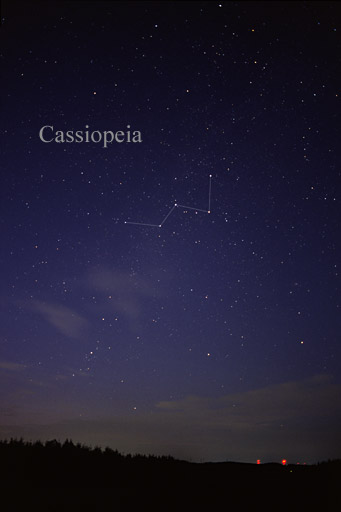Erick wrote:
Do you have any information on Cassiopeia’s Chair?
Erick, you’ve used the lovely old-fashioned name for this constellation. In the 1930s, the International Astronomical Union gave this constellation the official name of Cassiopeia the Queen. But sky watchers still see the chair, and speak of it.

The official borders of the constellation Cassiopeia (and all 88 constellations) were drawn up by the International Astronomical Union in the 1930s. Read more.

For much of the Northern Hemisphere, Cassiopeia is out all night long every day of the year. At present, Cassiopeia appears in the northwest at nightfall, and rather low in the north-northeast before dawn, as depicted above. Image credit: AlltheSky.com
Cassiopeia was an Ethiopian queen in ancient Greek mythology. According to legend, she boasted she was more beautiful than the sea nymphs called the Nereids. Her boast angered Poseidon, god of the sea, who sent a sea monster (Cetus the Whale) to ravage the kingdom. To pacify the monster, Cassiopeia’s daughter, Princess Andromeda, was left tied to a rock by the sea. Cetus was about to devour her when Perseus the Hero happened by on Pegasus, the Flying Horse. Perseus rescued the princess, and all lived happily . . . and the gods were pleased, so all of these characters were elevated to the heavens as stars.
Only Cassiopeia suffered an indignity. At nightfall, this constellation has more the shape of the letter M, and you might imagine the Queen reclining on her starry throne. But, at other times of year or night – as in the wee hours between midnight and dawn in February and march – Cassiopeia’s Chair dips below the celestial pole. And then this constellation appears to us on Earth more like the letter W. It’s then that the Lady of the Chair, as she is sometimes called, is said to hang on for dear life. If Cassiopeia the Queen lets go, she will drop from the sky into the ocean below, where the Nereids must still be waiting.
Back in stock! Order your 2016 EarthSky Lunar Calendar today!

W-shaped constellation Cassiopeia on left side of photo, above mountains. Meteor to far left, above Cassiopeia. Photo taken on the morning of April 19, 2013, by John Bozzell of Las Cruces, NM. Thank you John! View larger.
Bottom line: This post tells you how to find the constellation Cassiopeia the Queen on winter evenings, and it explains the mythology of this constellation.
A planisphere is virtually indispensable for beginning stargazers. Order your EarthSky Planisphere.
Enjoying EarthSky so far? Sign up for our free daily newsletter.
from EarthSky http://ift.tt/1A9eGQF
Erick wrote:
Do you have any information on Cassiopeia’s Chair?
Erick, you’ve used the lovely old-fashioned name for this constellation. In the 1930s, the International Astronomical Union gave this constellation the official name of Cassiopeia the Queen. But sky watchers still see the chair, and speak of it.

The official borders of the constellation Cassiopeia (and all 88 constellations) were drawn up by the International Astronomical Union in the 1930s. Read more.

For much of the Northern Hemisphere, Cassiopeia is out all night long every day of the year. At present, Cassiopeia appears in the northwest at nightfall, and rather low in the north-northeast before dawn, as depicted above. Image credit: AlltheSky.com
Cassiopeia was an Ethiopian queen in ancient Greek mythology. According to legend, she boasted she was more beautiful than the sea nymphs called the Nereids. Her boast angered Poseidon, god of the sea, who sent a sea monster (Cetus the Whale) to ravage the kingdom. To pacify the monster, Cassiopeia’s daughter, Princess Andromeda, was left tied to a rock by the sea. Cetus was about to devour her when Perseus the Hero happened by on Pegasus, the Flying Horse. Perseus rescued the princess, and all lived happily . . . and the gods were pleased, so all of these characters were elevated to the heavens as stars.
Only Cassiopeia suffered an indignity. At nightfall, this constellation has more the shape of the letter M, and you might imagine the Queen reclining on her starry throne. But, at other times of year or night – as in the wee hours between midnight and dawn in February and march – Cassiopeia’s Chair dips below the celestial pole. And then this constellation appears to us on Earth more like the letter W. It’s then that the Lady of the Chair, as she is sometimes called, is said to hang on for dear life. If Cassiopeia the Queen lets go, she will drop from the sky into the ocean below, where the Nereids must still be waiting.
Back in stock! Order your 2016 EarthSky Lunar Calendar today!

W-shaped constellation Cassiopeia on left side of photo, above mountains. Meteor to far left, above Cassiopeia. Photo taken on the morning of April 19, 2013, by John Bozzell of Las Cruces, NM. Thank you John! View larger.
Bottom line: This post tells you how to find the constellation Cassiopeia the Queen on winter evenings, and it explains the mythology of this constellation.
A planisphere is virtually indispensable for beginning stargazers. Order your EarthSky Planisphere.
Enjoying EarthSky so far? Sign up for our free daily newsletter.
from EarthSky http://ift.tt/1A9eGQF

Aucun commentaire:
Enregistrer un commentaire